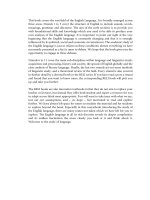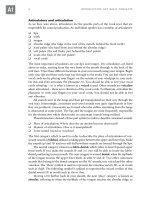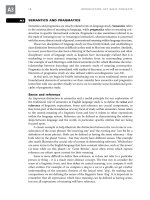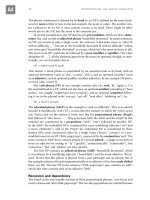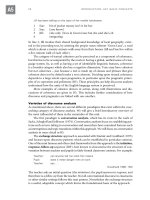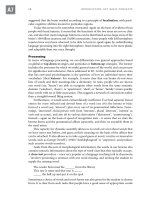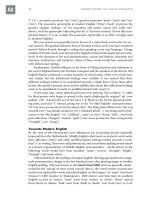Introdungcing English language part 52 pps
Bạn đang xem bản rút gọn của tài liệu. Xem và tải ngay bản đầy đủ của tài liệu tại đây (202.78 KB, 6 trang )
292 REFERENCES
Mondorf, B. (2000) ‘Sex differences in English syntax’, unpublished doctoral disser-
tation, Düsseldorf: University of Düsseldorf.
Mufwene, S. (2001) The Ecology of Language Evolution, Cambridge: Cambridge
University Press.
Murray, S. (1993) ‘Network determination of linguistic variables’, American Speech
68.2: 161–77.
Myhill, J. and Harris, W. (1986) ‘The use of the verbal -s inflection in BEV’, in
D. Sankoff (ed.) Diversity and Diachrony, Amsterdam: Benjamins, 25–32.
Newport, E. L., Gleitman, H. and Gleitman, L. R. (1977) ‘Mother, I’d rather do it myself:
some effects and non-effects of maternal speech style’, in C. Ferguson and C. Snow
(eds) Talking to Children: Language Input and Acquisition, Cambridge: Cambridge
University Press, 109–50.
Ochs, E. (1982) ‘Talking to children in Western Samoa’, Language in Society 11: 77–104.
Ochs, E. (1985) ‘Variation and error: a sociolinguistic study of language acquisition
in Samoa’, in D. Slobin (ed.) The Crosslinguistic Study of Language Acquisition,
Hillsdale: Lawrence Erlbaum Associates, 783–838.
Ochs, E. (1988) Culture and Language Development: Language Acquisition and
Language Socialization in a Samoan Village, Cambridge: Cambridge University
Press.
Ochs, E. and Schieffelin, B. (1984) ‘Language acquisition and socialization: three
developmental stories and their implications’, in R. Shweder and R. Levine (eds)
Culture Theory: Essays on Mind, Self and Emotion, New York: Cambridge
University Press, 276–320.
Ochs, E., Schegloff, E. and Thompson, S. (eds) (1996) Interaction and Grammar,
Cambridge: Cambridge University Press.
Odden, D. (2005) Introducing Phonology, Cambridge: Cambridge University Press.
OED (2009) World English dictionaries. Accessed 25 April 2009: oxford.
com/globalenglish/dictionaries/.
O’Grady, W. (2005) How Children Learn Language, Cambridge: Cambridge University
Press.
Orwell, G. (1948) Nineteen Eighty Four, London: Everyman.
Page, N. (1973) Speech in the English Novel, London: Longman.
Pascal, R. (1977) The Dual Voice, Manchester: Manchester University Press.
Pawley, A. and Syder, F. H. (1983) ‘Two puzzles for linguistic theory’, in J. Richards
and R. Schmidt (eds) Language and Communication, London: Longman, 192–226.
Pawson, R. (1989) A Measure for Measures: A Manifesto for Empirical Sociology,
London: Routledge.
Perakyla, A. (1997) ‘Reliability and validity in research based on transcripts’, in
D. Silverman (ed.) Qualitative Research: Theory, Method and Practice, London: Sage,
201–20.
Phillipson, R. (2002) ‘Global English and local language policies’, in A. Kirkpatrick
(ed.) Englishes in Asia: Communication, Identity, Power and Education,
Melbourne: Language Australia, 7–28.
Pitts, A. (1986) ‘Contrastive use of verbal -s in slave narratives’, in D. Sankoff (ed.)
Diversity and Diachrony, Amsterdam: Benjamins, 73–82.
Popper, K. and Eccles, J. C. (1977) The Self and Its Brain, Berlin: Springer.
REFERENCES 293
Pye, C. (1992) ‘The acquisition of K’iche’ Maya’, in D. Slobin (ed.) The Crosslinguistic
Study of Language Acquisition, Hillsdale: Lawrence Erlbaum Associates, 221–308.
Richards, L. (2005) Handling Qualitative Data: A Practical Guide, London: Sage.
Rimmon-Kenan, S. (1983) Narrative Fiction: Contemporary Poetics, London:
Methuen.
Roberts, C. and Sarangi, S. (2003) ‘Uptake of discourse research in interprofessional
settings: reporting from medical consultancy’, Applied Linguistics 24.3: 338–59.
Robson, M. and Stockwell, P. (2005) Language in Theory: A Resource Book for
Students, London: Routledge.
Rosewarne, D. (1984) ‘Estuary English’, Times Educational Supplement 42, 19
October.
Rossman, G. B. and Wilson, B. L. (1985) ‘Numbers and words: combining quantita-
tive and qualitative methods in a single large-scale evaluation study’, Evaluation
Review 9.5: 627–43.
Rubdy, R. and Saraceni, M. (2006) English in the World: Global Rules, Global Roles,
London: Continuum.
Russell, J. (1982) ‘Networks and sociolinguistic variation in an African urban setting’,
in S. Romaine (ed.) Sociolinguistic Studies in the Speech Community, London: Edward
Arnold, 125–40.
Sacks, H., Schegloff, E. and Jefferson, G. (1974) ‘A simplest systematics for the organ-
isation of turn-taking in conversation’, Language 50: 696–735.
Samuels, M. L. (1972) Linguistic Evolution, with Special Reference to English,
Cambridge: Cambridge University Press.
Sandelowski, M. (2003) ‘Tables of tableaux? The challenges of writing and reading
mixed methods studies’, in A. Tashakkori and C. Teddlie (eds) Handbook of Mixed
Methods in Social and Behavioral Research, Thousands Oaks: Sage, 321–350.
Sarangi, S. and Roberts, C. (1999) ‘The dynamics of interactional and institutional
orders in work-related settings’, in S. Sarangi and C. Roberts (eds) Talk, Work
and Institutional Order: Discourse in Medical, Mediation and Management
Settings, Berlin: Mouton de Gruyter, 1–57.
Schachter, S. (1959) The Psychology of Affiliation: Experimental Studies of the Sources
of Gregariousness, Stanford: Stanford University.
Schegloff, E. A., Jefferson, G. and Sacks, H. (1977) ‘The preference for self-correction
in the organization of repair in conversation’, Language 53: 361–82.
Schieffelin, B. (1986) ‘The acquisition of Kaluli’, in D. Slobin (ed.) The Crosslinguistic
Study of Language Acquisition, Hillsdale: Lawrence Erlbaum Associates, 525–94.
Schieffelin, B. (1990) The Give and Take of Everyday Life: Language Socialization of
Kaluli Children, Cambridge: Cambridge University Press.
Schiffrin, D., Tannen, D. and Hamilton, H. E. (eds) (2001) Handbook of Discourse
Analysis, Oxford: Blackwell.
Schmitt, N. and McCarthy, M. (1998) Vocabulary: Description, Acquisition and
Pedagogy, Cambridge: Cambridge University Press.
Schneider, E. (1983) ‘The origin of the verbal -s in Black English’, American Speech
58: 99–113.
Schneider, E. W. (2003) ‘The dynamics of new Englishes: from identity construction
to dialect rebirth’, Language 79.2: 233–81.
294 REFERENCES
Schooling, S. (1990) Language Maintenance in Melanesia, Dallas: SIL.
Schwandt, T. A. (2000) ‘Three epistemological stances for qualitative inquiry’, in
N. K. Denzin and Y. S. Lincoln (eds) Handbook of Qualitative Research, 2nd edn,
Thousand Oaks: Sage.
Scollon, S. (1982) ‘Reality set, socialization and linguistic convergence’, unpublished
Ph.D. thesis, Honolulu: University of Hawaii.
Searle, J. R. (1969) Speech Acts, Cambridge: Cambridge University Press.
Searle, J. R. (1979) Expression and Meaning, Cambridge: Cambridge University Press.
Seidlhofer, B. (2004) ‘Research perspectives on teaching English as a lingua franca’,
Annual Review of Applied Linguistics 24: 145–209.
Short, M. (1996) Exploring the Language of Poems, Plays and Prose, London: Longman.
Silverman, D. (2000) Doing Qualitative Research: A Practical Guide, London: Sage.
Silverman, D. (2004) Qualitative Research: Theory, Method and Practice, 2nd edn, London:
Sage.
Silverman, D. (2006) Interpreting Qualitative Data: Methods for Analyzing Talk, Text
and Interaction, 3rd edn, London: Sage.
Simpson, P. (2004) Stylistics: A Resource Book for Students, London: Routledge.
Simpson, P. and Mayr, A. (2009) Language and Power: A Resource Book for Students.
Abingdon: Routledge.
Sinclair, J. (1990) Collins COBUILD English Grammar, London: HarperCollins.
Sinclair, J. (1991) Corpus, Concordance, Collocation, Oxford: Oxford University Press.
Sinclair, J. (2004) Trust the Text, London: Routledge.
Sinclair, J. and Coulthard, M. (1975) Toward an Analysis of Discourse, Oxford: Oxford
University Press.
Singleton, D. (2000) Language and the Lexicon, London: Arnold.
Skehan, P. (1998) A Cognitive Approach to Language Learning, Oxford: Oxford
University Press.
Smith, J. (1996) An Historical Study of English: Function, Form and Change, London:
Routledge.
Smith, J. (2005) Essentials of Early English, 2nd edn, London: Routledge.
Smith, L. E. (1992) ‘Spread of English and issues of intelligibility’, in B. B. Kachru
(ed.) The Other Tongue: English Across Cultures, Chicago: Illinois University
Press, 75–90.
Smith-Hefner, B. (1988) ‘The linguistic socialization of Javanese children’,
Anthropological Linguistics 30.2: 166–98.
Sonntag, S. K. (2003) The Local Politics of Global English: Case Studies in Linguistic
Globalisation, Lanham: Lexington Books.
SPAS (2002) The SPAS manifesto. Accessed
25 April 2009.
Steinberg, D. and Sciarini, N. (2006) An Introduction to Psycholinguistics, 2nd edn,
London: Longman.
Steinberg, D., Nagata, H. and Aline, D. (2001) Psycholinguistics: Language, Mind and
World, London: Longman.
Stephenson, N. (1992) Snow Crash, New York: Bantam.
Stilwell Peccei, J. (2006) Child Language: A Resource Book for Students. Abingdon:
Routledge.
REFERENCES 295
Stockwell, P. (2007) Sociolinguistics: A Resource Book for Students, 2nd edn, Abingdon:
Routledge.
Strang, B. (1999) A History of English, London: Pan.
Street, B. V. (1984) Literacy in Theory and Practice, Cambridge: Cambridge University
Press.
Swales, J. (1989) Talking Voices, Cambridge: Cambridge University Press.
Swales, J. (1990) Genre Analysis, Cambridge: Cambridge University Press.
Swales, J. (1997) ‘English as Tyrannosaurus Rex’, World Englishes 16.3: 373–82.
Tannen, D. (1984) Conversational Style: Analyzing Talk Among Friends, New York: Ablex.
Tench, P. (1990) ‘The pronunciation of English in Abercrave’, in N. Coupland and
A. Thomas (eds) English in Wales: Diversity, Conflict and Change, Clevedon:
Multilingual Matters, 130–41.
Thomas, J. (1995) Meaning in Interaction, London: Longman.
Thompson, G. (2004) Introducing Functional Grammar, 2nd edn, London: Arnold.
Thompson, J. (1990) ‘Advertising’s rationality’, in M. Alvarado and J. Thompson (eds)
The Media Reader, London: British Film Institute.
Toolan, M. (2001) Narrative: A Critical Linguistic Introduction, 2nd edn, London:
Routledge.
Trask, L. (1995) Language: The Basics, London: Routledge.
Trask, L. and Stockwell, P. (2007) Language and Linguistics: The Key Concepts,
London: Routledge.
Trevarthen, C. (1979) ‘Communication and co-operation in early infancy: a descrip-
tion of primary intersubjectivity’, in M. Bullowa (ed.) Before Speech, Cambridge:
Cambridge University Press, 321–49.
Trudgill, P. (1974) The Social Differentiation of English in Norwich, Cambridge:
Cambridge University Press.
Ur, P. (1984) Teaching Listening Comprehension, Cambridge: Cambridge University Press.
Verdonk, P. (ed.) (1993) Twentieth Century Poetry: From Text to Context, London:
Routledge.
Verdonk, P. (2002) Stylistics, Oxford: Oxford University Press.
Verdonk, P. and Weber, J J. (eds) (1995) Twentieth Century Prose: From Text to Context,
London: Routledge.
Voss, B. (1984) Slips of the Ear, Tubingen: Gunter Narr Verlag.
Waldron, R. A. (1979) Sense and Sense Development, 2nd edn, London: Deutsch.
Wales, K. (2001) A Dictionary of Stylistics, 2nd edn, London: Pearson.
Ward, M. (1971) Them Children: A Study in Language, New York: Holt, Rinehart, and
Winston.
Wardhaugh, R. (1993) Investigating Language: Central Problems in Linguistics,
Oxford: Blackwell.
Wardhaugh, R. (2009) An Introduction to Sociolinguistics, 6th edn, Oxford: Blackwell.
Watson-Gegeo, K. and Gegeo, D. (1986) ‘Calling out and repeating routines in the
language socialization of Basotho children’, in B. Schieffelin and E. Ochs (eds)
Language Socialization across Cultures, Cambridge: Cambridge University Press,
17–50.
Wells, J. C. (1982) Accents of English (3 vols), Cambridge: Cambridge University
Press.
296 REFERENCES
Wenger, E. (1998) Communities of Practice: Learning, Meaning and Identity,
Cambridge: Cambridge University Press.
Wheatcroft, G. (2007) ‘Yo, Blair!’: Tony Blair’s Disastrous Premiership, London:
Hutchinson.
Whitney, P. (1998) The Psychology of Language, Boston: Houghton Mifflin.
Widdowson, H. (1997) ‘EIL, ESL, EFL: global issues and local interests’, World
Englishes, 16.1: 135–46.
Widdowson, H. (2003) Defining Issues in English Language Teaching, Oxford: Oxford
University Press.
Williams, C. H. (1990) ‘The anglicisation of Wales’, in N. Coupland and A. Thomas
(eds) English in Wales: Diversity, Conflict and Change, Clevedon: Multilingual Matters,
19–47.
Williamson, S. G. (1979) ‘Tamil baby talk: a cross-cultural study’, unpublished Ph.D.
dissertation, University of Pennsylvania.
Wolfram, W., Hazen, K. and Schilling-Estes, N. (1999) Dialect Change and
Maintenance on the Outer Banks, Tuscaloosa and London: University of Alabama
Press.
Wray, A. (2002) Formulaic Language and the Lexicon, Cambridge: Cambridge University
Press.
Young, M. and Wilmott, P. (1962) Family and Kinship in East London,
Harmondsworth: Penguin.
Yule, G. (2006) The Study of Language, 3rd edn, Cambridge: Cambridge University
Press.
Zimmerman, D. and West, C. (1975) ‘Sex-roles, interruptions and silences in con-
versation’, in B. Thorne, C. Kramarae and N. Henley (eds) Language, Gender and
Society, Rowley: Newbury House, 89–101.
accent 3, 8, 26, 35, 37, 59, 63–4, 84– 5, 86,
92, 94–6, 98– 9, 104, 118–25, 162, 168,
178, 192–9
access code 30
accommodation 96, 97, 232, 236
accusative 31, 32–4
acoustic phonetics 2
acquisition 23–7, 30, 85, 87, 226– 32, 256,
268
acrolect 165
actor 31, 75, 77, 258–63
Adams, Douglas 188
address terms 12, 84, 140, 143, 163, 222–6,
227–31
adjacency pair 79, 80
adjectival phrase (AdjP) 15, 16, 18
adjunct 74, 75–6, 78
adverb 16, 18, 74–5, 93, 99, 204, 215 –17,
221, 242
adverbial complement 75, 215–17
adverbial phrase (AdvP) 15, 16, 17–18, 26,
74–5, 93, 215
advertising 113, 119, 167–72, 220– 6
affix 7, 24, 28–9, 126
affricate 5, 60, 64
agent 26, 74, 75, 77, 258, 261–4, 277
agreement 9, 17, 37, 87, 219
Aldiss, Brian 173–4
alliteration 104, 122, 221
allophones 3
all-together-now (ATN) 81
alveolar 4–5, 59 –60, 63–4
ambiguity 12–13, 32, 68, 71, 76, 87, 127, 132,
133, 135–6, 200, 205, 217, 223– 4, 230–6
American 8, 9, 35, 37–8, 43, 79, 92, 95, 102,
125, 160, 162, 169, 219, 228–31, 248– 9,
255
anaphora 21, 220
antonymy 65, 66, 127–8
aphasia 27, 151–2, 155
apology 13, 71, 131–5, 201, 214
approximant 5, 59–60, 63, 105
Arabic 8, 160
articulators 2, 5, 34, 47, 51, 118, 194
articulatory phonetics 2–5, 58– 64
association 28–9, 64, 65– 6, 129, 151, 154,
243
assonance 122
attribute 77–8, 260, 263
auditory phonetics
2, 232
auxiliary 16, 17
–18, 26, 75
babbling 24, 25
back-formation 8, 9, 26, 126–7
Bantu 8
basic level term 66
basilect 165
behaver 77
behavioural process 77
bilabial 4, 59–60, 63 –4
Blake, William 127–8
borrowing 7, 8, 243
bottom-up processing 28
bound morpheme 6, 7, 9
Burns, Robert 119–22
Byron, George Gordon 103–6
captioning 86
cardinal vowels 61–2
carrier 78, 260
case 17, 24, 31–4
cataphora 21, 220
Celtic 8, 30–1
centralised vowels 62
GLOSSARIAL INDEX
Keywords (which are in bold throughout this book) are indicated here where a definition is
provided or the term is used in a context which makes its meaning clear. Other page
references are to places in the book where the term is also used.

